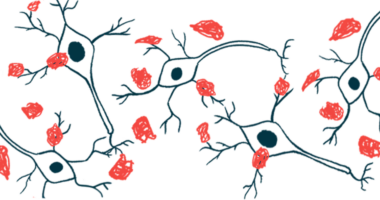UCB0599 reduces inflammation, improves coordination in mice
Experimental therapy is designed to keep alpha-synuclein in its proper shape

The experimental oral therapy UCB0599 — now in clinical trials — improves motor coordination and reduces inflammation and levels of the disease-related protein alpha-synuclein in a mouse model of Parkinson’s disease.
“This comprehensive package of [Parkinson’s]-relevant improvements supports the rationale of directly targeting misfolded [alpha-synuclein] with the small molecule minzasolmin [UCB0599] as a disease-modifying strategy in Parkinson’s disease,” the researchers wrote in “In vivo effects of the alpha-synuclein misfolding inhibitor minzasolmin supports clinical development in Parkinson’s disease,” which was published in npj Parkinson’s Disease. The work was funded by UCB, the company developing UCB0599.
Parkinson’s disease is marked by abnormal folding of the protein alpha-synuclein, which forms clumps in the brain that are toxic to brain cells and are thought to drive the disease. UCB0599 is designed to keep alpha-synuclein in its proper shape so it doesn’t clump.
UCB is running a Phase 2 clinical trial (NCT04658186) to test UCB0599 against a placebo in about 450 people with Parkinson’s.
How UCB0599 moved into clinical testing
In this study, scientists at UCB and Neuropore Therapies explained some of the preclinical research that helped move UCB0599 into clinical testing.
The scientists studied wild-type mice to characterize the pharmacological properties of the compound and showed UCB0599 is able to enter the brain, a key feature for any potential therapy that aims to target the brain.
The researchers then tested it in a mouse model of Parkinson’s known as the Line 61 transgenic mouse model. These mice are engineered to express high levels of human alpha-synuclein protein.
Without treatment, the mice showed notable deficits on the round beam test, an assessment of their walking ability. A 1 mg/kg dose of UCB0599 led to a statistically significant improvement in the test’s scores. A dose of 5 mg/kg also tended to improve scores, but the difference from untreated mice wasn’t statistically significant.
Analyses of the mice’s brains showed that both doses led to significant reductions in alpha-synuclein levels. The therapy also reduced levels of a form of the protein that’s resistant to some normal protein-clearing systems. This form of alpha-synuclein is thought to be particularly involved in Parkinson’s.
UCB0599 also led to increases in dopamine transporter (DAT) levels in the striatum, a part of the brain that’s heavily impacted in Parkinson’s. Dopamine is a chemical messenger that some nerve cells use to communicate with each other. Parkinson’s is caused by the death and dysfunction of dopamine-making cells in the brain. The dopamine transporter is a protein that plays a crucial role in regulating dopamine levels and acts like a recycling system for it.
The therapy also reduced levels of the protein GFAP, which is a marker of the inflammatory activation of astrocytes, a type of brain cell that normally supports nerve function. In neurological disorders like Parkinson’s disease their inflammatory activity can spur disease-driving damage in the brain, however.
Taking these findings together, the researchers concluded that, “Once daily administration of minzasolmin (UCB0599) for [three] months produced beneficial effects on disease-related [alpha-synuclein] neuropathology, neuroinflammation, and functional motor endpoints in the Line 61 mouse model of Parkinson’s disease.”
Throughout the experiments, there was no sign that UCB0599 caused notable health problems in the mice, supporting its safety profile. A previous clinical trial in healthy volunteers suggested that the therapy was generally well tolerated.







